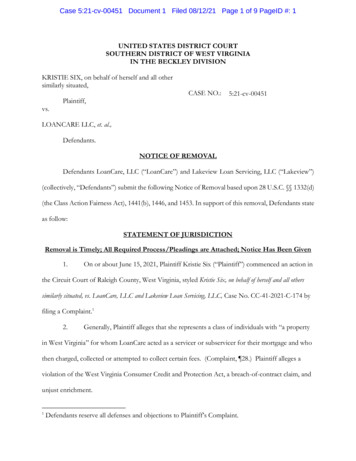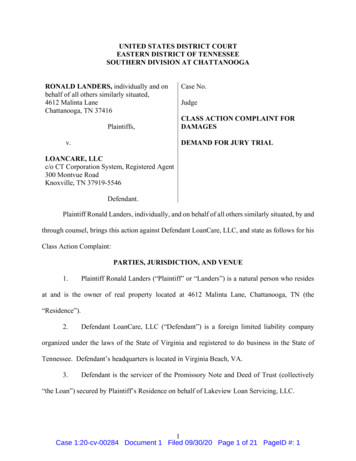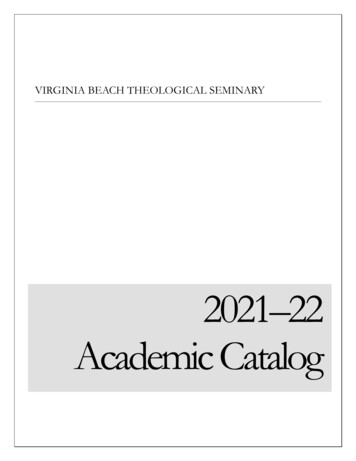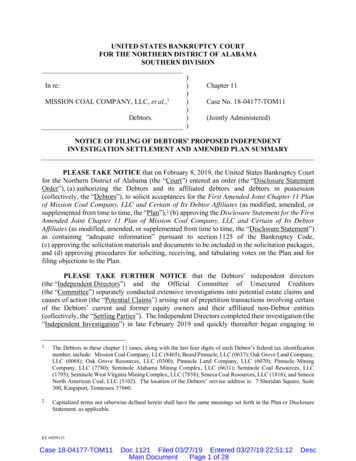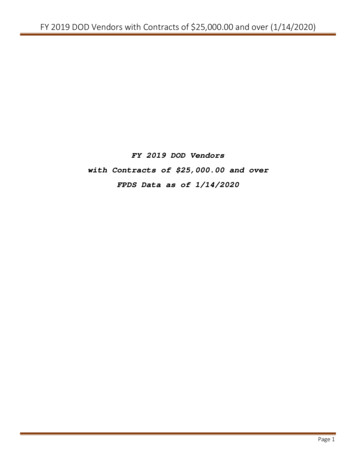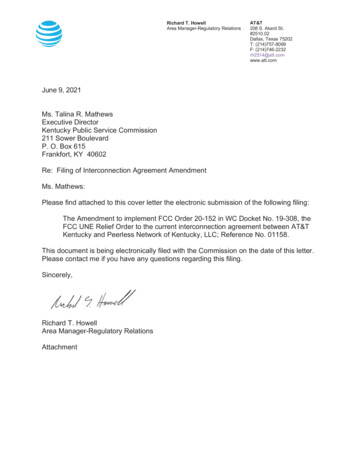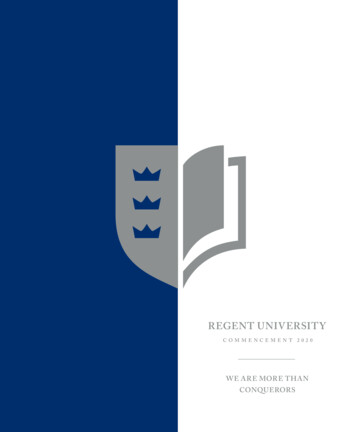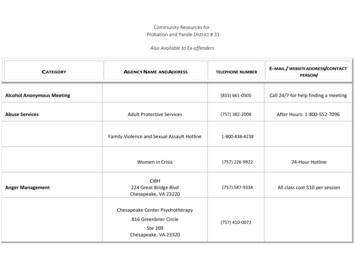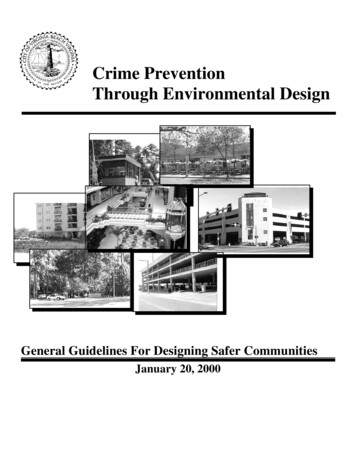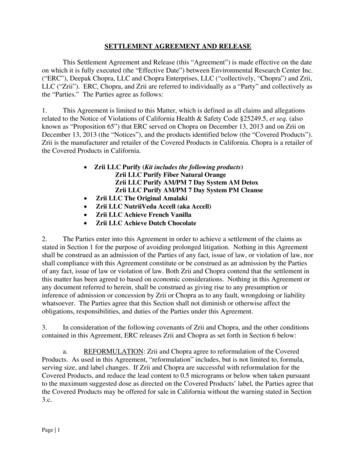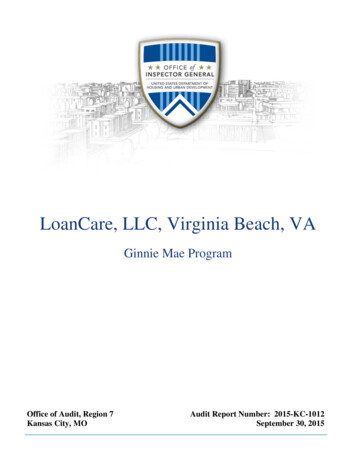
Transcription
LoanCare, LLC, Virginia Beach, VAGinnie Mae ProgramOffice of Audit, Region 7Kansas City, MOAudit Report Number: 2015-KC-1012September 30, 2015
To:From:Subject:Michael Drayne, Senior Vice President, Office of Issuer and PortfolioManagement,TS//signed//Ronald J. Hosking, Regional Inspector General for Audit, 7AGALoanCare Did Not Always File Claims for Foreclosed-Upon Properties Held onBehalf of Ginnie Mae and Convey Them to FHA in a Timely MannerAttached is the U.S. Department of Housing and Urban Development (HUD), Office of InspectorGeneral’s (OIG) final results of our review of LoanCare’s master subservicer responsibilitiesrelated to foreclosed-upon properties held on behalf of the Government National MortgageAssociation (Ginnie Mae).HUD Handbook 2000.06, REV-4, sets specific timeframes for management decisions onrecommended corrective actions. For each recommendation without a management decision,please respond and provide status reports in accordance with the HUD Handbook. Please furnishus copies of any correspondence or directives issued because of the audit.The Inspector General Act, Title 5 United States Code, section 8M, requires that OIG post itspublicly available reports on the OIG Web site. Accordingly, this report will be posted athttp://www.hudoig.gov.If you have any questions or comments about this report, please do not hesitate to call me at913-551-5870.
Audit Report Number: 2015-KC-1012Date: September 30, 2015LoanCare Did Not Always File Claims for Foreclosed-Upon Properties Heldon Behalf of Ginnie Mae and Convey Them to FHA in a Timely MannerHighlightsWhat We Audited and WhyWe audited LoanCare, LLC, because of concerns that the Government National MortgageAssociation’s (Ginnie Mae) single-family master subservicers did not file claims with theFederal Housing Administration (FHA) for foreclosed-upon properties in a timely manner. Ouraudit objective was to determine whether LoanCare conveyed foreclosed-upon properties held onbehalf of Ginnie Mae, filed claims with FHA, and remitted the funds to Ginnie Mae on time.What We FoundLoanCare did not always convey properties to FHA, file claims with FHA, or remit claim fundsto Ginnie Mae on time. It did not always (1) convey foreclosed-upon properties to FHA within30 days of acquiring possession and title, (2) file the part B portion1 of its conveyance claimwithin 45 days of the date the deed was filed for record or within 15 days of the title approvalletter date, and (3) remit FHA claim funds to Ginnie Mae within 2 business days. As a result,FHA’s insurance fund was subjected to additional costs, and Ginnie Mae was unable to recoverits costs on time.What We RecommendWe recommend that Ginnie Mae require LoanCare to repay any additional costs associated withthe violations noted.1Servicers file claims with FHA on form HUD-27011, Single-Family Application for Insurance Benefits. Theclaim form has two parts: Part A: General Information and Part B: Fiscal Data.
Table of ContentsBackground and Objective.3Results of Audit .4Finding 1: LoanCare Did Not Always Take Timely Actions on Foreclosed-UponProperties Held on Behalf of Ginnie Mae . 4Scope and Methodology .7Internal Controls .8Appendixes .9A. Auditee Comments and OIG’s Evaluation . 9B. File Review Summaries . 172
Background and ObjectiveLoanCare is a nonsupervised mortgage company approved to operate by the U.S. Department ofHousing and Urban Development (HUD) since May 27, 1986. It is headquartered in VirginiaBeach, VA, and is a Government National Mortgage Association (Ginnie Mae) authorized issuerof mortgage-backed securities. It was contracted with Ginnie Mae to be a single-family mastersubservicer from 2009 until 2014, when its contract expired. As a Ginnie Mae single-familymaster subservicer, its duties included providing services in connection with issuer defaults andservicing current, delinquent, and defaulted loans, including foreclosure services, managementand disposition of acquired properties, and preparation and submission of insurance or guaranteeclaims to the Federal Housing Administration (FHA), U.S. Department of Agriculture RuralDevelopment (RD), U.S. Department of Veterans Affairs (VA), and HUD’s Office of Public andIndian Housing (PIH). Specifically, LoanCare was required to service the mortgages or theinstallment loan contracts in accordance with relevant agency regulations, its contract withGinnie Mae, and the Ginnie Mae Mortgage-Backed Securities (MBS) Guide.Ginnie Mae is a unique program in that it uses the explicit full faith and credit guarantee of theU.S. Government to back its mortgage-backed securities. Ginnie Mae is authorized by Title IIIof the National Housing Act, as amended, to guarantee the timely payment of principal andinterest on securities that are issued by approved entities and which are backed by FHA, VA,RD, or PIH mortgages. It does not make or purchase mortgage loans, nor does it buy, sell, orissue securities. Instead, private lending institutions approved by Ginnie Mae originate eligiblegovernment loans, pool them into securities, and issue mortgage-backed securities. Ginnie Mae,in turn, guarantees the performance of the lenders that issue the securities and that continue toservice and manage the underlying loans.When a Ginnie Mae-approved issuer defaults, Ginnie Mae steps into the role of the issuer andmakes the timely pass-through payments to investors and then assumes the servicing rights andobligations of the issuer’s entire Ginnie Mae-guaranteed pooled loan portfolio of mortgagebacked securities using its master subservicer.Our objective was to determine whether LoanCare conveyed foreclosed-upon properties held onbehalf of Ginnie Mae, filed claims with FHA, and remitted the funds to Ginnie Mae on time.3
Results of AuditFinding 1: LoanCare Did Not Always Take Timely Actions onForeclosed-Upon Properties Held on Behalf of Ginnie MaeLoanCare did not always convey properties to FHA, file claims with FHA, or remit claim fundsto Ginnie Mae on time for 10 loans reviewed. It believed that the delays were justified andbeyond its control, and it did not understand that such delays were allowable only if it receivedan extension from FHA. As a result, FHA’s insurance fund was subjected to additional costs,and Ginnie Mae was unable to recover its costs on time.Delayed ActionsLoanCare did not always convey foreclosed-upon properties to FHA, file claims with FHA, andremit claim funds to Ginnie Mae on time. The table below breaks down these deficiencies.Post-foreclosure DelaysUntimely actionsConveying property to FHAFiling part B claim with FHARemitting funds to Ginnie MaeNumber of properties with delays6 of 65 of 64 of 5Ten loans were reviewed, but not all aspects could be evaluated for each loan. See appendix Bfor further details.Delayed ConveyanceLoanCare did not always convey foreclosed-upon properties to FHA on time. Regulations at 24CFR 203.359 require servicers to convey properties to FHA within 30 days of acquiringpossession and title. Possession is defined as when the property is vacant. LoanCare conveyedfive of the properties reviewed between 91 and 370 days after it took possession of them. It didnot convey a sixth property, instead transferring it to a new master subservicer 59 days afteracquiring possession.In addition, LoanCare did not always remove personal property from foreclosed-upon homeswithin the 30-day timeframe. HUD Handbook 4330.4, paragraph 2-2(D)(4), states that theservicer must act promptly to ensure that all personal property has been removed within 30 daysafter acquiring title and possession.For example, on one loan, LoanCare completed the removal of personal property 140 days afterit acquired possession and conveyed the property on day 268.4
Delayed Filing of Part B of the ClaimLoanCare did not always file the part B portion of its conveyance claim within the requiredtimeframe. HUD Handbook 4330.4, paragraph 2-2(H), states that the servicer must submit partB of form HUD-27011 to FHA within 45 days of the date the deed is filed for record or submit itwithin 15 calendar days of the approval letter received date, whichever is later. LoanCare filedpart B of the conveyance claim for two of the loans reviewed between 51 and 55 days after thedeed was recorded or approval letter received date. It did not file part B for three additionalproperties, instead transferring them to a new master subservicer after the 45 days had passed.Delayed Remittance of FundsLoanCare did not always remit FHA claim funds to Ginnie Mae on time. Its contract withGinnie Mae required it to remit all claim funds received by the second business day followingreceipt of the funds. LoanCare did not meet this requirement for four of the five loans reviewed,remitting funds on the third to fifth business days.Misunderstood Requirements for DelaysLoanCare believed that the delays were justified and beyond its control, and it did not understandthat such delays were allowable only if it received an extension from FHA. During the audit,LoanCare noted that the delays in conveying the properties and filing claims were justified andbeyond its control because in many cases, the properties needed repairs before they would be inconveyance condition and also the records needed to file the claims were often difficult to obtain.LoanCare had inherited these loans from defaulted issuers so it had not been responsible for theloans during all of the servicing. In several cases, property condition issues prevented timelyconveyance. However, these reasons did not fully account for the delays and in several cases,damages or title defects occurred after the conveyance deadline. For example, in one case,LoanCare identified roof damage 14 days after it took possession of the property but failed toconvey it for a full year. LoanCare did not understand that to exceed the established timeframes,it needed to request and receive an extension of time from FHA. It did not request an extensionfor any of the sampled items as it believed that once the prior servicer had missed the initialdeadline to file for foreclosure, an extension request was not necessary since interest was alreadybeing curtailed. However, HUD Handbook 4330.4, section 2-3, states that if the servicer cannotcomply with the time requirements for a particular action because of circumstances beyond itscontrol, it should submit a form HUD-50012 to FHA to request an extension of time.Financial ImpactAs a result of LoanCare’s noncompliance, the FHA fund was subjected to additional costs, andGinnie Mae was unable to recover its costs on time.The delays in conveyance caused the FHA insurance fund to pay out more claim funds forproperty preservation costs, such as lawn maintenance, repairs, and inspections, as well as hazardinsurance costs and property taxes.Also, Ginnie Mae advanced funds to LoanCare to reimburse it for property preservation costsand the costs of eviction and repairs. When LoanCare did not convey the properties to FHApromptly, Ginnie Mae had to continue advancing funds for property preservation costs during thedelay. Further, the delays in filing the part B claims and remitting claim funds to Ginnie Maeresulted in Ginnie Mae’s carrying these costs longer than necessary before receiving5
reimbursement. Ginnie Mae’s liquid assets were reduced until it could recover the costs fromFHA’s insurance fund, and it missed out on potential interest from the delayed remittances.ConclusionLoanCare did not take prompt actions on foreclosed-upon properties it serviced for Ginnie Mae.These delays negatively impacted FHA’s insurance fund because of extra outflows. They alsoaffected Ginnie Mae due to delays in receiving claim funds and lost interest. Because LoanCareis no longer contracted by Ginnie Mae to perform this function, we are not recommending thatGinnie Mae require it to receive training or change its practices. However, Ginnie Mae shouldrequire LoanCare to return any funds that it was not entitled to receive for servicing the sampledloans.RecommendationWe recommend that Ginnie Mae1A. Require LoanCare to repay any additional costs associated with the violations noted.6
Scope and MethodologyOur audit period generally covered October 1, 2013, through September 30, 2014. Weperformed our audit work from May through September 2015. We conducted onsite work atLoanCare’s home office located at 3637 Sentara Way, Virginia Beach, VA.To accomplish our objective, we Reviewed the Code of Federal Regulations and HUD handbooks;Reviewed the contract between Ginnie Mae and LoanCare;Reviewed LoanCare’s audited financial statements;Reviewed relevant documents in the loan files, such as inspection reports, claimpackages, reconveyance notices, case chronologies, and other legal documents;Reviewed information in Neighborhood Watch, a HUD system designed to providecomprehensive data for tracking the performance of loans originated, underwritten, andserviced by FHA-approved lenders;Reviewed claim remittances; andInterviewed LoanCare and HUD employees.We selected a sample of 10 loans for review. This was a sample of five properties conveyed toHUD and five properties transferred to another master subservicer, Selene Finance. For loansthat were conveyed to HUD, we determined the number of days between when the foreclosuresale was completed and the date the property was conveyed to HUD. We then selected the fiveproperties that had the greatest number of days between the foreclosure sale completion date andthe conveyance to HUD date, which ranged between 882 and 1,491 days for the five loansselected. For loans that were transferred to Selene Finance, we determined the number of daysbetween when the foreclosure sale was completed and the date the property was transferred toSelene Finance. We then selected the five properties that had the greatest number of daysbetween the foreclosure sale completion date and the transfer to Selene Finance date, whichranged between 1,178 and 1,851 days for the five loans selected. The conclusions reached on thesampled items cannot be projected due to the selection method used.We used LoanCare’s information system to identify properties that were conveyed to HUD andthose that were transferred to Selene Finance, as well as the time between the foreclosure salecompletion and the conveyance or transfer. We used this information to select our sample andrelied upon it for background information only as all of our conclusions were based on ourreview of original source documents.We conducted the audit in accordance with generally accepted government auditing standards.Those standards require that we plan and perform the audit to obtain sufficient, appropriateevidence to provide a reasonable basis for our findings and conclusions based on our auditobjective(s). We believe that the evidence obtained provides a reasonable basis for our findingsand conclusions based on our audit objective.7
Internal ControlsInternal control is a process adopted by those charged with governance and management,designed to provide reasonable assurance about the achievement of the organization’s mission,goals, and objectives with regard to Effectiveness and efficiency of operations, Reliability of financial reporting, and Compliance with applicable laws and regulations.Internal controls comprise the plans, policies, methods, and procedures used to meet theorganization’s mission, goals, and objectives. Internal controls include the processes andprocedures for planning, organizing, directing, and controlling program operations as well as thesystems for measuring, reporting, and monitoring program performance.Relevant Internal ControlsWe determined that the following internal controls were relevant to our audit objective: Controls to ensure that all foreclosed-upon properties were conveyed to HUD within therequired timelines after the foreclosure sales and evictions were completed.We did not assess the relevant controls identified above because of the limited scope of the audit.8
AppendixesAppendix AAuditee Comments and OIG’s EvaluationRef to OIGEvaluationAuditee CommentsComment 19
Auditee Comments and OIG’s EvaluationRef to OIGEvaluationAuditee CommentsComment 210
Auditee Comments and OIG’s EvaluationRef to OIGEvaluationAuditee CommentsComment 511
Auditee Comments and OIG’s EvaluationRef to OIGEvaluationAuditee CommentsComment 3( Loan 1)Comment 4( Loan 2)12
Auditee Comments and OIG’s EvaluationRef to OIGEvaluationAuditee CommentsComment 5( Loan 3)Comment 6( Loan 4)Comment 7( Loan 5)13
Auditee Comments and OIG’s EvaluationRef to OIGEvaluationAuditee CommentsComment 8( Loan 6)Comment 9( Loan 7)Comment 10( Loan 8)Comment 8( Loan 9)Comment 10( Loan 10)Comment 1114
OIG Evaluation of Auditee CommentsComment 1Our audit objective was to determine whether LoanCare conveyed foreclosedupon properties held on behalf of Ginnie Mae, filed claims with FHA, andremitted the funds to Ginnie Mae on time. This involved verifying that LoanCarewas in compliance with all of HUD’s regulations as well as its contract. It is notsufficient to just notify Ginnie Mae and HUD about servicing issues but LoanCarealso had to comply with the regulations involving timely conveyance and claimfiling.Comment 2The audit focused on the conveyance and claim timelines after the foreclosuresales were completed, any legal challenges in eviction were resolved, andLoanCare had possession and title to the properties. Therefore the “robo signing”issues and foreclosure delays were before the part of the process our audit wasconcerned with and were not relevant to LoanCare’s ability to convey theproperties after it had possession.Comment 3LoanCare did not provide any documentation to show that HUD would not grantan extension for the delayed conveyance or to show any attempt to obtain anextension of the conveyance timelines for loan 1. We have amended the table inappendix B to show that HUD received the part B claim within 8 days of titleapproval and revised the report with the addition of HUD criteria allowing for thepart B claim to be filed up to 15 days after HUD approves the title.Comment 4For loan 2, LoanCare conveyed the property 144 days after it obtained possession,well beyond the 30-day limit. The title issue did not delay the conveyance asHUD was the one that discovered the issue after the conveyance.Comment 5For loan 3, LoanCare obtained possession when the property was vacated in July2012. LoanCare had contact with the former principal of Ironwood (Smaller) inJanuary 2013, after which he deeded the property to another company. LoanCarewas not aware of the title issues until May 2013, about two weeks after itconveyed the property in April 2013. LoanCare should have conveyed theproperty in August 2012, well before any title issues arose.Comment 6Based on the information provided for loan 4, we recalculated the number of daysthat LoanCare took to file the claim from 116 to 51. We updated the table inAppendix B to show the corrected number of days. However, LoanCare was stilllate in filing the claim.Comment 7For loan 5, LoanCare’s property preservation records show that the property wasvacant and the locks changed on 06/06/2013 and therefore they should haveconveyed it by 07/06/2013. Its records show that the property was vandalizedafter the required conveyance date.15
Comment 8Our report did not include any findings for missed timeframes for these loans(loans 6 and 9).Comment 9For loan 7, LoanCare did not provide any evidence of a service release stop andflag before 07/27/2014, which was the required conveyance date. In addition, on08/01/2014, LoanCare’s system log notes stated that the property was ready to beconveyed and that it was awaiting recording instructions.Comment 10 While LoanCare did document its effort with HUD to resolve the situation, it didnot file the part B within FHA’s timeframes or submit an extension request toreceive written approval to exceed these timeframes for these loans (loans 8 and10).Comment 11 Ginnie Mae will not only consider interest but other costs when calculating theamount to be repaid, therefore 1.62 would be understating its potential recovery.16
Appendix B#LoannumberFile Review SummariesDays betweenPossession Possession Deed filingandandor andremovalsubmissionof part BclaimsRemittances(businessdays toremit claimfunds toGinnie Mae)a) Same dayb) Same dayc) 33a) 3b) 2c) 5a) 2b) 6 45 4 C5150005340344370AB60005341318DDD70005287669 30 B 30 BB80006566558EE 45 B90005219985DDD100006559827ConveyedTransferred toSelene FinanceTransferred toSelene FinanceTransferred toSelene FinanceTransferred toSelene FinanceTransferred toSelene FinanceEE 45 BF5 of 64 of 5Number of delays6 of 6FFFA – The file does not reveal the personal property removal date or has conflicting information.B – Transferred to Selene Finance without taking the relevant actionC – Conflicting information in the file but personal property removed within 30 daysD – LoanCare never had possession of the property; it transferred the loan to Selene Finance.E – The defaulted issuer conveyed the property before LoanCare serviced the loan.F – LoanCare did not receive claim funds from FHA for the loan, so it had none to remit to Ginnie Mae.17
To: Michael Drayne, Senior Vice President, Office of Issuer and Portfolio Management,TS //signed// From: Ronald J. Hosking, Regional Inspector General for Audit, 7AGA Subject: LoanCare Did Not Always File Claims for Foreclosed-Upon Properties Held on Behalf of Ginnie Mae and Convey Them to FHA in a Timely Manner Attached is the U.S. Department of Housing and Urban Development (HUD), Office of .
